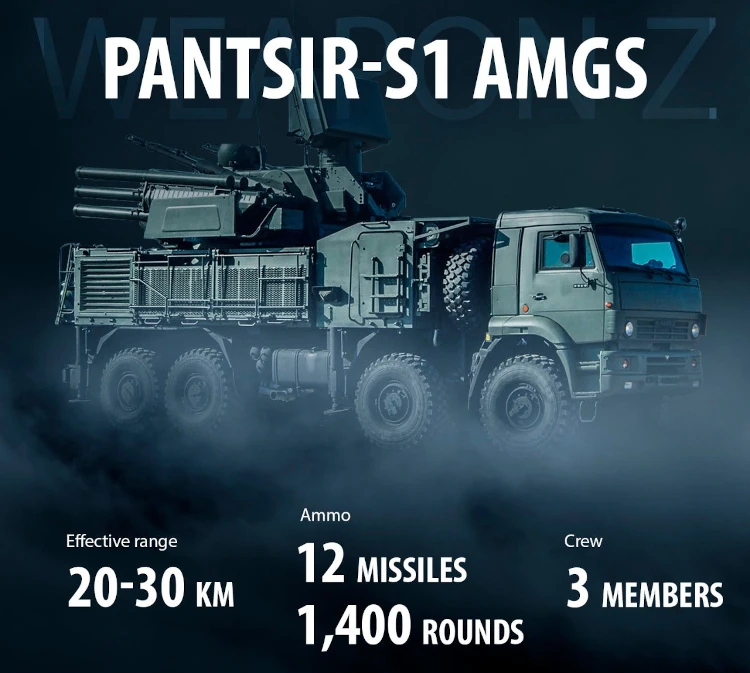The Russian government has begun examining alternatives for securing its vital energy facilities with “Pantsir-S1” anti-aircraft systems, according to Artem Verkhov, Director of the Department of Gas Industry Development at Russia’s Ministry of Energy. The Russian official also stated plans to shield oil and gas installations from Ukrainian strikes with strike drones.
“We are working together, including with colleagues from the Russian National Guard, on covering objects and installing defence systems like ‘Pantsir’,” said Artem Verkhov, Director of the Department of Gas Industry Development at the Ministry of Energy of the Russian Federation.
Despite the remarks, the ZU-23-2 small-calibre anti-aircraft gun remains the Russian National Guard’s most powerful air defence weapon. At present, only the Russian Armed Forces use Pantsir systems in Russia.
However, it is known that in the middle of last year, following the suppression of mercenaries from the Wagner Private Military Company, discussions grew hot about moving tanks and other heavy weapons to the Russian National Guard’s arsenal.
Russian anti-aircraft gun installations have already been identified as part of the layered air defence surrounding the Russian capital, which has been in place since early last year to protect against Ukrainian drones.
Modular structures have been seen on the roofs of downtown Moscow near significant administrative buildings, such as the Kremlin, and specific towers across the city.
In terms of characteristics, the Pantsir-S1 anti-aircraft missile gun system (AAMGS) is the best suited among Russian anti-aircraft systems for countering drone attacks because it can operate autonomously, relying solely on its own radar data and relatively inexpensive interception means—two 30 mm guns and radio-guided anti-aircraft missiles.
Furthermore, the Pantsir is a multi-channel air defence system that can intercept many targets simultaneously, critical during large-scale drone strikes.
However, Russia possesses a limited number of such systems, all of which are involved in either the conflict against Ukraine or the security of other targets. As a result, these AAMGS will be removed from other sites to protect the oil refineries, weakening their defence.

Ukraine and Russia attack each other’s Energy Resources
Since the beginning of 2024, Ukraine has significantly increased its offensive activities against Russia, conducting a prolonged campaign of drone and missile strikes against crucial energy facilities within Russian territory. This is a significant strategic shift from Ukraine’s previous concentration on fighting against Russian aggression to carrying the battle to Russia itself.
Major oil refineries have been the principal targets. Kyiv looks to be attempting to undermine Russia’s ability to produce cash from oil and gas exports, which have been a vital economic lifeline in funding Moscow’s invasion of Ukraine.
According to estimates, the cumulative impact of these strikes has already lowered Russia’s total oil refining and processing capacity by 7-10%. Several significant refineries, including the enormous Novokuibyshevsk complex outside Samara, have temporarily ceased operations due to damage from Ukrainian attacks.
Even though the strikes by Ukraine within Russia are a step up, it’s crucial to remember that Russia has been attacking the energy sector of Ukraine since the first few weeks of its full-scale invasion in February 2022.
Power plants, electrical substations, pipelines, and other energy infrastructure have all been regularly targeted by Russian missile and artillery barrages throughout Ukraine. Degrading Ukraine’s energy networks and utilities has been Russia’s declared objective to lower citizen morale and weaken the nation’s ability to resist.
Millions of Ukrainians have occasionally been left without water, heat, or electricity due to widespread blackouts, particularly during winter cold snaps. As of early 2023, energy specialists predict that 40–50% of Ukraine’s energy system was affected by Russian strikes.
According to Ukraine, Russia has turned electricity into a weapon and is engaging in “energy terrorism” by purposefully destroying civilian infrastructure, which is against the rules of armed combat. The humanitarian catastrophe in Ukraine is partly attributable to the energy strikes.
Therefore, even though Ukraine’s drone and missile operations inside Russia signify a growth in the geographic reach of the energy attacks, they can also be seen as a response and a well-reasoned attempt at practical self-defence against Russia, which has been attacking Ukraine’s energy grids nonstop since the invasion began.
Both sides’ attacks on energy facilities, tit-for-tat, have escalated the stakes and created the possibility of additional escalation in this area of economic warfare between the two enemies. This emphasises how this war’s interconnected energy infrastructure has turned into a battlefield.
If the situation worsens, these strikes might seriously disrupt the world’s energy markets and drive up the price of refined goods like petrol, natural gas and oil. Russia and Ukraine are important global suppliers.
